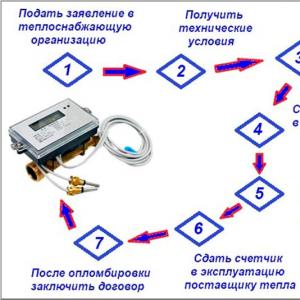What is grounding. Designations What is grounding based on
Protective grounding is a deliberate electrical connection to the ground or its equivalent of metal non-current-carrying parts that may become energized due to a short to the case and for other reasons (inductive effect of neighboring current-carrying parts, potential removal, lightning discharge, etc.).
Protective grounding is designed to eliminate the risk of electric shock in case of contact with the body of the electrical installation and other non-current-carrying metal parts that are energized due to a short to the body and for other reasons.
The scope of protective grounding is electrical installations with voltage up to 1000 V in networks with an isolated central and above 1000 V in networks with any neutral mode of the current source (both isolated and dead-earthed).
In accordance with the requirements of GOST 12.1.030-81, protective grounding of an electrical installation should be performed:
at rated voltage of 380V and above AC and 440V and above DC in all cases;
at rated voltages from 42V to 380V AC and from 110V to 440V DC when working in conditions with increased danger, especially dangerous and outdoor installations.
Note: The characteristics of these conditions are given in the mandatory annex to GOST 12.1.013-78.
Protective grounding is applied to metal parts of electrical installations and equipment that are accessible to human touch and do not have other types of protection, for example, cases of electrical machines, transformers, lamps, switchboard frames, metal pipes and electrical wiring shells, etc.
The principle of operation of protective grounding in electrical installations with voltage up to 1000V:
decrease in the touch voltage on the grounded case when the supply voltage is shorted to it.
This is achieved due to the low resistance of the grounding device (Ohm). Current flows along the path of least resistance, and since human resistance (  kOhm), then it will go to the ground electrode or its equivalent.
kOhm), then it will go to the ground electrode or its equivalent.
Schematic diagram of protective grounding is shown in Fig.:

(a) - three-phase network; (b) - two-wire networks of alternating current and (c) - direct current.
Note: the maximum allowable values of touch voltages and currents through the human body, taking into account the duration of exposure, are given in GOST 12.1.038-82.
Grounding is carried out using special devices - grounding conductors- this is a set of grounding conductors - metal conductors in contact with the ground, and grounding conductors connecting the grounded parts of the electrical installation with the grounding conductor.
Depending on the relative position of the grounding conductors and the equipment to be grounded, remote and loop grounding devices are distinguished. The first of them are characterized by the fact that the ground electrodes are placed outside the site on which the grounded equipment is located, or are concentrated on some part of this site (Fig. 20.4).

Loop grounding device (Fig. 20.5), the ground electrodes of which are located along the contour (perimeter) around the grounded equipment at a small distance from each other (several meters), provides a better degree of protection than the previous one

Grounding conductors are single and group, artificial and natural.
Group grounding consists of vertical rods and a horizontal strip connecting them.
As natural grounding conductors use:
Water pipe laid in the ground;
Well casing pipes (metal);
Lead sheaths of cables laid in the ground;
Other metal structures located in the ground.
The total resistance of the grounding device consists of the resistance of natural and artificial grounding conductors:

where  - the required (permissible) value of the resistance of the grounding device.
- the required (permissible) value of the resistance of the grounding device.
Requirements for protective grounding resistance are regulated by the PUE. At any time of the year, this resistance should not exceed 4 ohms
Electricity is man's best friend and worst enemy. Of course, now it is almost impossible to imagine life without it. Unfortunately, there were some bad moments, such as electric shock. You can be shocked if you touch not only a bare current-carrying part, but also a harmless-looking body of an electrical appliance. In this article we will try to explain in simple terms what grounding is and what it is intended for. In addition, we will consider what a difavtomat and RCD are and what they are used for.
Concept definition
In short and simple terms:
Grounding is a device that protects a person from electric shock if all electrical equipment is connected to the ground. In an emergency, dangerous voltage "flows" to the ground.
Protection is the main purpose of grounding. It consists in connecting an additional, third ground conductor to the wiring, which is connected to a device such as a ground electrode. He, in turn, has good contact with the ground.
Grounding is working and protective for its intended purpose. The worker is necessary for the normal functioning of the electrical installation, the protective one is necessary to ensure electrical safety (prevention of electric shock).
Usually, grounding (ground electrode) looks like three electric rods driven into the ground, at the same distance from each other, located at the corners of an equilateral triangle. These rods are interconnected by a metal strip. You could see such rods near houses and structures.

You may also have noticed that metal strips are fixed on the walls of many buildings inside or outside, sometimes painted with yellow and green alternating stripes - this, it is also connected to the ground electrode. A ground bus is needed in order not to pull a ground wire from each electrical installation.
The third conductor is usually connected to the housing of electrical appliances, providing protection against the appearance of dangerous voltage on it. In cables, it usually has a smaller cross section than adjacent "working" cores and a different color of insulation - yellow-green.
Grounding Requirements
The requirements for a protective earth loop are as follows:
- All electrical installations must be grounded, including the metal doors of electrical cabinets and shields.
- The resistance of the grounding device must not exceed 4 ohms in electrical installations with a grounding neutral.
- Nessesary to use .
We figured out what grounding is, now let's talk about what it is for.
Why does a person get electrocuted
Consider two typical situations when you are shocked:
- The washing machine did its job properly, and when you wanted to turn it off, you felt that its body was “pinching” you. Or even worse, when you touched it - you were seriously “twitched”.
- You decided to take a bath, turned on the water, holding the tap, you felt the same effect of electricity - a tingling or a strong blow.

Both situations are solved by connecting grounding to the instrument cases and all metal parts in the bathroom and installing an RCD or differential machine at the input of electricity to a house or a group of consumers.
How grounding works
To begin with, let's figure out why a dangerous voltage appeared on the body of a washing machine or other electrical equipment. Everything is quite simple - the insulation of the conductors for some reason deteriorated or was damaged and the damaged area touches the metal case of one of the equipment parts.
If there is no grounding or zeroing of electrical equipment, then when a person touches a damaged device, it may occur (potential difference on the surface between the points of contact). If you are near damaged equipment, you may experience (potential difference between feet in contact with the ground). The touch voltage and step voltage can be dangerous to humans. To reduce their value to a safe value, protective grounding is used.
Even such small values as 50 mA are dangerous for a person - such a current can lead to ventricular fibrillation and death.
So the principle of operation of grounding is as follows: the cases of all electrical appliances are connected to the ground electrode, and an RCD is additionally installed. In the event of a dangerous voltage on the case, grounding always attracts a dangerous potential to a safe ground potential and the voltage "drains" to ground.
What are RCDs and difavtomatov used for?
Simply grounding devices is fine, but it's even better to provide additional protection. For this, they came up with (RCD) and.
A difavtomat is a device that combines an RCD and a conventional circuit breaker in its case, so you save space in the electrical panel.

RCD - responds only to. The principle of its operation is as follows: it compares the amount of current through the phase and through the neutral wire, if part of the current has flowed to the ground, then it instantly reacts, turning off the circuit. They are distinguished by sensitivity from 10 to 500 mA. The more sensitive the RCD, the more often it will work, even with minor leaks, but you should not install too rough an RCD for your home.
The principle of operation of a secure circuit in simple terms:
When a phase enters the body of grounded electrical equipment, current begins to flow between the phase wire and the body. Then the RCD notices that a current has passed through the phase wire, part of the current has to be done somewhere and a smaller current has returned through the neutral wire, after which this circuit is de-energized. So you are protected from electric shock.
If you install an RCD in a two-wire electrical circuit without a ground conductor and there is a possibility of current leakage somewhere, it will work only after you touch this place and the current will flow to the ground through you. In this case, you will be safe too.
That's all we wanted to say about this issue. Now you know what grounding is, when and how it is installed and what it serves. We hope that the information was presented for you in a clear and understandable way!
grounding
Form start
End of form
Warning: the article is purely informative and is not a normative document. When performing work related to electricity, you should be guided by the Electrical Installation Rules (PUE).
Definitions
grounding- this is a deliberate connection of non-current-carrying equipment elements, which, as a result of insulation breakdown, may become energized, with the ground. Grounding consists of a grounding conductor (a conductive part or a set of interconnected conductive parts that are in electrical contact with the ground directly or through an intermediate conductive medium) and a grounding conductor connecting the grounded device to the grounding conductor. The grounding conductor can be a simple metal rod (most often steel, less often copper) or a complex set of special-shaped elements. The quality of grounding is determined by the value of the electrical resistance of the grounding circuit, which can be reduced by increasing the contact area or the conductivity of the medium - using many rods, increasing the salt content in the ground, etc. As a rule, the electrical resistance of grounding is normalized. Main ground clamp. To minimize electromagnetic interference and maintain electrical safety, grounding should be performed with a minimum number of closed loops. Ensuring this condition is possible when performing the so-called main ground clamp (GZZ), or bus. The main earth clamp should be located as close as possible to the input power and communication cables and connected to the earth electrode(s) with the shortest conductor length. This location of the GZZ provides the best potential equalization and limits the induced voltage from industrial interference, lightning and switching overvoltages coming from the outside through the screens of communication cables, armor of power cables, pipelines and antenna bushings. To GZZ (tire) must be attached: 
grounding conductors;
protective conductors;
conductors of the main potential equalization system;
working ground conductors (if necessary).
Grounding conductors for protective and working (technological, logical, etc.) grounding, lightning protection grounding conductors, etc. must be connected to the main grounding clamp (bus). exposed conductive part- a conductive part of an electrical installation accessible to touch that is not normally energized, but which may become energized if the basic insulation is damaged. Open conductive parts include metal cases of electrical equipment. live part- the electrically conductive part of the electrical installation, which is under operating voltage during its operation. indirect touch- electrical contact of people and animals with open conductive parts that are energized when the insulation is damaged. That is, this is a touch on the metal case of electrical equipment during the breakdown of insulation on the case.
Notation
Protective ground conductors in all electrical installations, as well as zero protective conductors in electrical installations with voltage up to 1 kV with a solidly grounded neutral, including tires, must have a letter designation RE and color designation by alternating longitudinal or transverse stripes of the same width (for tires from 15 to 100 mm) of yellow and green colors. Zero working (neutral) conductors are indicated by the letter N and blue. Combined zero protective and zero working conductors must have a letter designation PEN and color designation: blue color along the entire length and yellow-green stripes at the ends. Graphic symbols used to designate conductors in diagrams:

Grounding designation:
Letter designations of the grounding system
The first letter in the designation of the grounding system determines the nature of the grounding of the power source:T– direct connection of the neutral of the power supply to the ground; I– all current-carrying parts are isolated from the ground. The second letter determines the nature of the grounding of the open conductive parts of the electrical installation of the building: T- direct connection of the open conductive parts of the electrical installation of the building with the ground, regardless of the nature of the connection between the power source and the ground; N- direct connection of open conductive parts of the electrical installation of the building with the grounding point of the power source. The letters following through the dash behind N determine the nature of this connection - a functional way of arranging the zero protective and zero working conductors: S– functions of zero protective PE and zero working N conductors are provided by separate conductors; C- the functions of the zero protective and zero working conductors are provided by one common PEN conductor.
Errors in the grounding device
Wrong PE conductors Sometimes water pipes or heating pipes are used as a ground conductor, but they cannot be used as a ground conductor. There may be non-conductive inserts in the plumbing (such as plastic pipes), the electrical contact between the pipes may be broken due to corrosion, and finally, a part of the pipeline may be dismantled for repair.

Combining a working zero and a PE conductor Another common violation is the union of the working zero and the PE conductor beyond the point of their separation (if any) along the distribution of energy. Such a violation can lead to the appearance of quite significant currents in the PE conductor (which should not be current-carrying in the normal state), as well as to false trips of the residual current device (if installed).

Incorrect separation of the PEN conductor The following way of “creating” a PE conductor is extremely dangerous: a working neutral conductor is determined directly in the socket and a jumper is placed between it and the PE contact of the socket. Thus, the PE conductor of the load connected to this outlet is connected to the working zero. The danger of this circuit is that a phase potential will appear on the grounding contact of the socket, and, consequently, on the case of the connected device, if any of the following conditions are met:
Rupture (disconnection, burnout, etc.) of the neutral conductor in the area between the socket and the shield (and further, up to the grounding point of the PEN conductor);
Swapping the phase and zero (phase instead of zero and vice versa) conductors going to this outlet.

By creating an electrical connection of metal structures of industrial and domestic equipment with the ground, safety is increased during its operation. This method is used to prevent electric shock to a person in case of emergency.
The figure below shows the basic principles of the functioning of the protective system. Even when using high-quality automatic devices, the speed of their shutdown will be insufficient to completely eliminate the possibility of electric shock to a person. In the presence of grounding, a circuit with less resistance will be formed. This will reduce the harmful effects on the human body to a safe level.
Protective grounding is a necessary safety element to prevent electric shock
Principle of operation
It is usually installed for protection in the event of a short circuit. If the phase conductor is disconnected and touches the metal chassis of the unit, the housing will be energized.
A properly created protective earth forms an electrical circuit with low resistance. It is this path that is most favorable for electric current, so an accidental touch of a person to the body will not be dangerous (Fig. above).
It should be noted that such a device will simultaneously perform several important functions:
- It will also provide protection in the event that a potentially dangerous voltage on the case is formed not by a short circuit, but by induction currents. Such situations are possible in installations with high voltage and where exposure to microwave radiation is acceptable.
- When using a dead-earthed neutral and some other connection schemes in the power circuit, in the event of a short circuit, long and large-amplitude pulses will occur, sufficient to trigger the automata that turn off the voltage.
- If grounded equipment is struck by lightning, such a conductor will provide some protection against damage.
According to this formula, the resistance of the conductor of the protective circuit between the main bus and the switchboard is calculated: 50 x STsFN / LV. STsFN - resistance in the zero-phase circuit; LV - nominal voltage in volts.
In order not to be mistaken with the terminology, one must understand the real meaning of the following names:
- The worker is called grounding, which acts as a second conductor. It is used for electrical power supply of installations, solving other problems.
- The lightning protection mentioned above is not intended. To ensure safety during thunderstorms, devices specially designed for this purpose are used. They are designed for relatively large currents and voltages.
Wiring diagrams
To choose the best option, you need to know for what purposes protective grounding is used in a particular case. Below are the different systems, their features, advantages and disadvantages.
Type TN, solidly earthed. According to this scheme, industrial and household equipment is connected, operating in networks with voltages up to and above 1000 V. The neutral of the generator (transformer) of the power source is connected to the ground electrode. Consumer devices, or rather cases, screens, chassis, are connected to a common conductor.
If the electrical circuit is created in accordance with international standards, then the following can be understood from the inscriptions. The Latin letter "N" denotes the "zero" conductor, which is used to operate the equipment. It's called functional. "PE" is a conductor used to create a protective circuit. The letters "PEN" denote a conductor designed to solve functional and protective tasks.
The following schemes are most often used. Their names are distinguished by a letter, which is added to "TN" through a hyphen.
Wiring diagrams
| System | Principle of operation | Advantages, disadvantages, features |
|---|---|---|
| C | In the "C" system, the conductor performs working and protective functions at the same time. As an example, we can recall a typical three-phase power supply with a solidly grounded neutral, which is a neutral wire. | This scheme is relatively simple and economical. Housings of consumer devices are connected directly to the neutral. The disadvantage is the loss of protective properties if the electrical circuit is broken. Such damage cannot be excluded in case of an emergency increase in current, heating and destruction of the conductor. In such a situation, a dangerous voltage will appear on the case. When using such systems, automatic machines are especially carefully selected, which should quickly and reliably turn off the supply voltage. |
| S | This circuit uses two separate neutral conductors, working and protective. | Several conductors increase the cost of the system, but significantly increase the reliability of protection. |
| C-S | This is a combined system. The generating source is connected to a dead-earthed neutral. Only four conductors go to the consumer (three-phase power supply). A protective conductor "PE" is added to the property. | Low cost compared to the previous option is accompanied by lower reliability. If the conductor is damaged in the area to the object (or to "PE"), the protective functions will be lost. In accordance with current regulations, when using such systems, it is required to prevent mechanical damage to the relevant conductors. |

The most commonly used connection schemes
Sufficiently high risks arise when using overhead power lines. They can be damaged by a hurricane, other negative external influences. To ensure a high level of security, the TT scheme is used.
A solidly grounded neutral is connected to the generator. Energy is transmitted through four wires. At the consumer, an autonomous grounding system is installed, to which the equipment cases are connected.
Kinds
To minimize the resistance, it is desirable to shorten the length of the protective conductor. This is ensured by creating a ground loop around the perimeter of the object.
Remote systems are used when equipping installations that operate with a supply voltage of up to 1,000 V.
Grounding conductors are also divided into artificial and natural. This distribution by groups is conditional, since in both cases metal parts of structures located in the ground are used:
- In the first, they are created specifically for the grounding system. This approach allows you to accurately calculate the resistance, the dimensions of individual parts, and other important parameters.

Natural grounding - a metal part of a structure located in the ground
- The second option provides for connection to the metal parts of the building structure, reinforcement of foundation blocks. It is more economical, since some finished parts are used for protection. However, it must be borne in mind that in order to connect the equipment, it will be necessary to lay the appropriate lines, which will have a resistance determined by the standards. The disadvantage is the relative accessibility of ordinary personnel.
For grounding use conductors made of copper, black and galvanized steel. Cross-sections and other characteristics of products are selected taking into account the electrical parameters of the installation and its operating conditions.
In particular, the level of humidity matters. When calculating, the resistivity and other features of the soils are checked.
Grounding is the electrical connection of the electrically conductive components of the equipment to the ground. It consists of a grounding conductor and a conductor connected to it. The figure below shows the classic connection diagram.
Ground connection diagram in a private house
Red indicates phase, blue indicates neutral. They go from the pole from the main power supply, respectively, to the L and N buses. The ground wire connected between the ground electrode and the PE bus of the shield is indicated in black. They go into the shield, from which wiring is made around the house.
Kinds
Depending on why grounding is needed, it is distinguished by types:
- Working. In industry, points of current-carrying parts of electrical installations are grounded to create normal working conditions. Electrical safety is not the goal here. Working grounding is intended for the operation of electrical equipment in emergency mode, when a breakdown occurs on the case or damage to the insulation. This is how the neutral of the generator or transformer is grounded.
Working grounding is done directly with a grounding conductor or through additional devices (reactors, resistances, arresters).
- Protective. Grounding is intended to protect a person so that he is not struck by an electric current. The body conducts electricity and has a lot of resistance. Electric shock occurs not only as a result of touching conductive elements. In this case, an electrical circuit must still be formed. It is created between the ground, on which a person rests with his feet, and a bare conductor, under voltage, with which contact occurs.
The higher the humidity of the earth's surface, the more current will pass through the body, which is a significant danger.
- From lightning. At the place of the lightning strike, the temperature reaches 30 thousand degrees, which threatens the lives of people and the safety of buildings. Statistics show that 20% of fires in private homes are caused by lightning. Therefore, it is necessary to install lightning rods on buildings.
Protection system
The protection system includes 3 parts:
- Lightning rod - catches the blow and transmits the current further. It is a round rod with a diameter of at least 10 mm and a length of 250 mm. It is located on the roof, at a high altitude, where there is a maximum probability of a discharge.
The radius of the protection zone at the base of the rod is determined by the formula:
r = 1.732∙h, where
h is the height difference between the upper points of the house and the lightning rod.
Consideration should also be given to the conical shape of the space to be protected.
- Down conductor - serves to transfer current from the lightning rod to the ground electrode. For it, a wire rod with a diameter of 6 mm is used, which is welded to the lightning rod, after which it is lowered along the wall to the ground electrode with a maximum distance from windows and doors. The down conductor must not be bent so that a spark discharge does not occur in this place. It is made as short as possible.
- Lightning protection grounding and household appliances are made common. The most common device is in the form of a circuit of three electrodes driven into the ground and interconnected by a steel strip by welding. The earthing switch is located at a distance of more than 1 m from the walls and more than 5 m from the porch, walkways and walkways.

Lightning protection system for a private house
Natural ground
To create grounding, it is convenient to use metal parts of buildings and structures that are in contact with the ground. This may be foundation reinforcement, underground pipelines or cable sheaths, ground communications (railways). All this can be used only in cases where all the requirements for grounding conductors are met. The advantage of this method is significant cost savings and no need to operate the devices.
Foundations are often used as a ground electrode, but certain conditions must be met for this:
- humidity of the surrounding soil is not lower than 3%;
- the absence of an aggressive environment that contributes to the occurrence of corrosion;
- the reinforcement is not under the influence of mechanical stress;
- all parts of metal structures constitute an inextricable electrical circuit, for which jumpers with a cross section of at least 100 mm 2 are welded into the gaps;
- the presence in concrete of embedded metal parts with which a grounding conductor can be connected.
Protective earth
The main element is a ground loop, consisting of metal electrodes located in the ground. They are rods, angles, pipes or sheets with a length of at least 2.5 m. Their main task is to dissipate current in the soil, the effectiveness of which depends on the composition of the soil and climate.
When installing grounding, you need to know what the soil consists of. It can be clay, sand, earth, etc.
Each component has its own electrical conductivity, which determines how to properly design the ground. Clay has a resistance of 20 Ohm * M, sand - 10-60 Ohm * M (depending on humidity), garden soil - 40 Ohm * M, gravel - 300 Ohm * M.
A ground conductor is connected to the circuit.

Triangular ground loop
Electrodes are not allowed to be coated with dielectric anti-corrosion compounds. You can only apply varnish to the welding points.
The requirements for the conductor from the circuit to the electrical installation are strength and resistance to corrosion. The conductors can be steel tapes with a size of 5x30 mm and rods with a diameter of 10 mm or more. Due to the small load, a wire rod with a diameter of 6 mm is suitable for giving.
According to modern standards, electrical wiring in an apartment or in a private house is carried out with a three-wire wire, where one of them is a phase, the other is zero, and the third is grounding. Protection is connected between the circuit and the housings of electrical appliances. Sockets and plugs are equipped with grounding contacts connected to the device case, when turned on, in addition to electricity, grounding is connected.
When the phase hits the housing, due to the wear of the insulation, a leakage current occurs, which enters the circuit and dissipates in the ground. For small currents, the RCD is triggered, and for a short circuit - circuit breakers. In both cases, the current from the body of the electrical appliance passes through the protective conductor, designated PE, to the circuit and spreads in the ground.
The higher the electrical characteristics of the ground electrode, the more it protects a person from electric shock.
For private housing construction, the resistance of the protective ground loop under different conditions is:
- protective - from mains voltage at 220V or 380V - 30 Ohm (TN-C-S system);
- gas pipeline to the house - 10 ohms;
- lightning protection - 10 Ohm;
- telecommunications equipment - 2 or 4 ohms.
Earthing systems for electrical installations
Protective earthing systems depend on the characteristics of the power supply, such as an isolated or solidly earthed neutral. There are only three of them:
- The TN system contains a dead-earthed neutral, with the connection of metal parts of the electrical installation to it.

What does a TN system look like?
Depending on the ways to use the zero worker (N) and protective (PE) conductors in the system, subgroups are formed:
- TN-C - combination of PE and N conductors in one wire along the entire length of the network to the consumer (the old Soviet scheme, which is not currently used);
- TN-C-S - combination of PE and N conductors in one wire from a transformer substation with their separation at the entrance to the switchboard. This system requires additional grounding.
- TN-S - separation of neutral and protective wires throughout the network (the safest scheme).
- IT system with isolated or resonantly connected neutral. Here, non-conductive metal parts of electrical equipment have a separate ground.

What does an IT system look like?
The IT system is used in institutions where particularly sensitive equipment operates.
- A TT system with a solidly grounded neutral, and consumers have a separate protective ground (mainly modular-pin), not connected to the neutral wire N.

What does TT look like?
Video. Types of grounding
Grounding is necessary in all power supply networks, including in private houses and apartments. First of all, it is a security system when using electricity.







